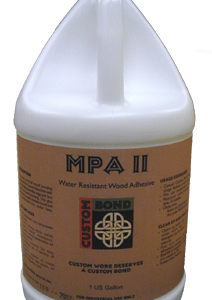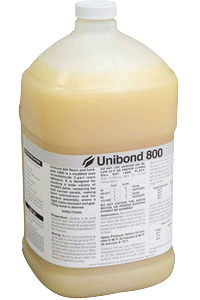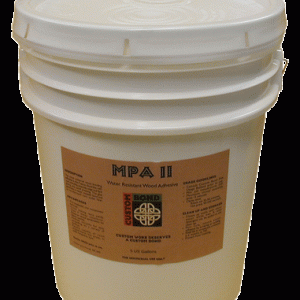Description
Urea Resin – Plastic Powdered Resin (PPR) – Tan
Urea resins are a truly versatile adhesive, capable of most assembly gluing, face and edge gluing, laminating and veneering. Urea resin glue line characteristics: strong, rigid, thermoset, Type II water resistance, and excellent heat resistance. Powdered Plastic Resin (PPR) product may be hot pressed, cold pressed, vacuum bagged or radio frequency (RF) cured. See download section for complete Technical data sheet
Mixing:
Water is necessary to reconstitute the powder resin. Amount of water used should be 50-65% of the weight of the dry powder to be mixed.
* 65% is the ideal level of water.
* With the amount of required water determined, first add 2/3 of that amount of water to the mixing
vessel.
* Slowly add the powder, while stirring the mix on slow RPM’s (<2,000) with a mechanical agitator.
* Continue mixing for 3-5 minutes, using a spatula to scrape powder from the sides back into the liquid. Mix should be creamy and virtually lump-free at this point.
* Add the remaining 1/3 water and mix for an additional minute. Mix should be smooth, creamy, and lump-free.
Spread:
Spread rate will largely depend on the nature of the work being done and the method of cure employed. Thin spreads are critical when working with raw veneer in order to reduce the effect of bleed through. Bleed through is the occurrence of glue seeping through the pores of the wood to show up on the face of the panel. Be aware of the thickness of your veneer and relative porosity of the species you’re working with, and adjust the spread accordingly. In many instances, a thin spread coupled with mandatory open assembly time (perhaps up to 10 minutes) will be necessary to prevent excessive bleed-through.
The amount of glue squeezed out while under pressure is still a good determinant as to how your spread level is. Remember, it’s not only the amount of glue, but also how consistently it was applied, and squeeze out can give you indications of each.
Pot Life Pot Life
Once mixed with water, the resin will advance in its cure stage until it is unusable. The amount of time between first mixed until it reaches the unusable point is termed pot life. As with most directions for gluing, this is a dynamic value. It will change, primarily due to temperature. Hotter temperatures yield a shorter pot life and vice versa. There is no problem putting mixed resin in the refrigerator to extend its pot life; however, it should not reach below 55°F, as it will thicken to the point where it won’t spread well.
* At 70°F pot life will be 5-1/2 hours, and @ 90°F will be 3 hours.
* The adhesive will continue to cure until it is rock hard—generally within 24 hours.
* Only experience and a careful eye will tell you the point when the mix is unusable, so err on the side of performance rather than yield. When it has thickened to the point that it is not spreading well, consider the mix unusable.
Assembly Times:
Urea resins offer very generous assembly times, making them ideal for intricate work requiring longer lay-up time. Once again, these are dynamic, dependent on spread rate, substrate porosity, moisture content, and temperature—both ambient and stock temp.
* As temperature increases, allowable assembly times decrease. Max. assembly time @ 70°F is 40 minutes, and @ 90°F is 20 minutes.
Cleanup:
Ureas are water-based products and therefore can be cleaned up with water. Warm water is preferred, as either cold or hot water will make clean-up more difficult. Eliminate as much of the adhesive from surfaces to be cleaned as possible, prior to adding water. The straight adhesive should be collected in a bucket and allowed to sit until cured completely, which leaves a solid plug of urea. This can be discarded as solid waste in a dumpster.
Safety
As with the use of any industrial chemical, proper care should be taken when handling urea adhesives. These are specifically outlined in the MSDS, available at veneersystems.com as a PDF download.




